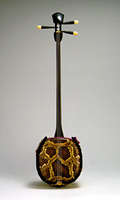Calligraphy
Of the famous calligraphers of the period, three are outstanding, Sonnen Gusukuma of the Oie school of calligraphy in the 17th century, as well as Teishu and Teikakun who were famous as calligraphers and studied in China in the late 16th century.
Tea ceremony
Zen priests introduced the Tea ceremony in the early 17th century. The Buddhist priest, Sakai was appointed master of tea ceremony and this art spread through the upper class. The Tea ceremony was performed to entertain foreign diplomats. A teahouse, Ochaya Udun, was built in the Sakiyama area of Shuri during the reign of King Sho Tei. Ryukyuans also developed a unique tea ceremony called Buku Buku Cha, a whipped tea made from roasted brown rice.
Music
Ryukyuan music developed from music performed for rites and ceremonies. The Sanshin (Okinawan samisen) originated from China in the 14th century and influenced songs and dancing. In the 18th century, the Ryukyuan music scoring system called Kururunshi or Kunkunshi was devised. Originally the Sanshin was used by only by the royal court, but its popularity spread throughout the islands and has become the quintessential instrument of Okinawa.
Dance
Ryukyuan Dance evolved out of sacred singing and dancing for religious ceremonies and from the entertaining dances of the common folk. Dancing after the latter era of the Ryukyu Kingdom is divided into the Ryukyuan Classical Dance that developed in the royal court, the "Zo-odori", or Popular Dance, that emerged out of the dissolution of the kingdom in the Meiji Era, and the folk dances handed down regionally since ancient times. Examples of which are the Eisa dances and Shisamai (Chinese lion dances).
